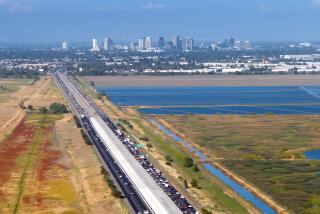PERSPECTIVES ON BOND ISSUES : Bonds Have Bombed; Try Tolls : With voters in an anti-tax mood and gas-tax value shrinking, toll lanes make sense; 91 Freeway will test them.
- Share via
Once again, California taxpayers have delivered a striking blow to the government’s best-laid plans. Defeat of the $2-billion earthquake-bond measure leaves state transportation plans seriously short of funds. In order to keep freeway earthquake retrofitting moving forward, Gov. Pete Wilson has moved to delay at least $1-billion worth of freeway and rail projects. Thus, freeway bottlenecks, needed high-occupancy vehicle lanes and badly needed repaving and modernization all will have to wait--unless we can come up with another source of funds.
In the current anti-tax mood, another increase in the gasoline tax or the sales tax will face tough sledding. Gasoline taxes are unpopular and our sales tax already puts California at a disadvantage compared with neighboring states. That leaves just one other choice: tolls.
A growing number of transportation-policy experts think that the gasoline tax should be phased out and replaced with direct-user payments. Steadily increasing fuel economy and the advent of alternate fuels will continue to shrink the real value of gas-tax receipts, further imperiling the health of the infrastructure. Tolls can be fine-tuned to make sure that heavy trucks truly pay their way. And by increasing the tolls at rush-hours in congested cities like Los Angeles, people will have strong incentives not to drive alone at those times. Moreover, technology has given us low-cost, nonstop electronic toll-collection systems that make toll booths as obsolete as blacksmith shops.
A major benefit of shifting toward tolls is the ability to leverage scarce government highway funds with private capital. Many California highways, freeways and bridges could be self-supporting from tolls alone. That projected revenue stream is bankable: Investors will put up funds to build a new bridge or modernize a highway if they can count on being repaid from toll revenues.
Four years ago, the Legislature tested this idea by authorizing Caltrans to request proposals from the private sector for four new toll facilities as pilot projects. The four projects selected after a grueling competition represent $2.5 billion in net new investment in California’s transportation system. The first of these is now under construction in Orange County, adding four express lanes to the Riverside (91) Freeway.
Congress took note of California’s experiment and decided it was a good idea to attract private capital into the nation’s highway system. The Intermodal Surface Transportation Efficiency Act contains innovative public/private partnership provisions to do just that. Traditionally, states have been required to match their federal highway funds with state funds, typically 80% federal to 20% state. Under the new provisions, California could use a portion of its federal funds to attract private funds. In many cases, just 25% or 33% of a project would be federal, with the balance coming from investors, not the state. The upshot: The same federal dollars would stimulate much greater total activity.
Federal Highway Administrator Rodney Slater endorsed this approach last fall when he told reporters, “We’ve got to get the private sector involved to a greater extent in financing highways.” Last year, Washington state enacted legislation to implement this new approach. Last month, the state’s Department of Transportation received proposals from 11 consortiums for 14 projects valued at $4.8 billion. They will select up to six for fast-track development. Sad to say, California has so far failed to follow through. Draft legislation to implement the public-private partnership provisions of the Transportation Efficiency Act has been floating around Sacramento for nearly two years, but the governor has failed to give it his blessing. Yet Washington state’s recent experience demonstrates that private capital and expertise are available, willing and able to step forward to help solve California’s infrastructure crisis.
Gov. Wilson’s approval ratings grew dramatically when he gave the private sector performance incentives to rebuild L.A.’s quake-damaged freeways. A bold program to enlist the private sector to modernize our transportation system could gain him further points. On the other hand, Kathleen Brown is an expert on bonds and infrastructure finance. Searching for new ideas to make California great again, Brown could steal a march on Wilson by embracing the idea of public/private partnerships.
Business as usual will not restore California’s greatness. Modern “smart highways” infrastructure will make California a better place to live and work. Our political leaders need to get behind such innovative approaches.
More to Read
Sign up for Essential California
The most important California stories and recommendations in your inbox every morning.
You may occasionally receive promotional content from the Los Angeles Times.










